Please Take Note: This is a review of the final game, but it might change slightly based on the success of the Kickstarter campaign. The game is being reviewed on the components and the rules provided with the understanding that “what you see is not what you might get” when the game is published. If you like what you read and want to learn more, we encourage you to visit the game publisher’s website or visit the Kickstarter campaign. Now that we have all that disclaimer junk out of the way, on with the review.

The Basics:
- For ages 13 and up
- For 2 to 4 players (up to 6 with expansion)
- Approximately 60 minutes to complete
Geek Skills:
- Active Listening & Communication
- Counting & Math
- Logical & Critical Decision Making
- Reading
- Strategy & Tactics
- Risk vs. Reward
- Cooperative & Team Play
- Hand/Resource Management
Learning Curve:
- Child – Moderate
- Adult – Moderate
Theme & Narrative:
- Earth is no more. All that remains is you, a few survivors, and an uncertain future.
Endorsements:
- Gamer Geek accepted!
- Parent Geek mixed!
- Child Geek rejected!
Overview
The message was short and full of static, but its meaning was clear. “Attention!…Giant asteroid…approaching…Earth…no time…save yourself…” That was the last message from Earth before it was struck by an asteroid the size of the Moon. You and the other ship captains now hold the most precious cargo in the universe: the last of the human race. Your only mission now is to find a new home and make certain humanity survives. Succeed and live. Fail and become extinct.
Last Starfleet, designed by Amit Ghadge, Sam Oplinger, and to be published by Wicked Grin Games LLC, will reportedly be comprised of 1 Plant board (double-sided), 140 People tokens (in the values of “1”, “5”, and “10)”, 21 “Leviathan” Planet cards, 21 “Red Planet” Planet cards, 15 “Perils of the Void” Orbit cards, 23 “Interpol Vengeance” Ship cards, 23 “HMS Providence” Ship cards, 23 “SS Transformation” Ship cards, and 23 “Gadget” Ship cards. Out of the Ship cards, 3 are reserved for the player’s Ship Mat (which are put together to form an area to organize game components). Additionally, 1 card from each Planet deck contains a description of the planet. As this is a review of a game prototype, we will not comment on the game component quality. Artists Amit Ghadge and Filip Dudek did a wonderful job capturing the game’s gritty thematic science fiction feel, further strengthening the game’s narrative.
Arriving at the Planet
To set up the game, first select a Planet deck and read the “Description” Planet card out loud. The type and size of planet, as well as the planet’s Nemesis, is defined. Set the “Description” Planet card off to one side of the game playing area. Place any Planet decks not used back in the game box.
Second, set the Planet board in the middle of the game playing area. A lot will happen on the planet, so let’s get to know your possible new home.
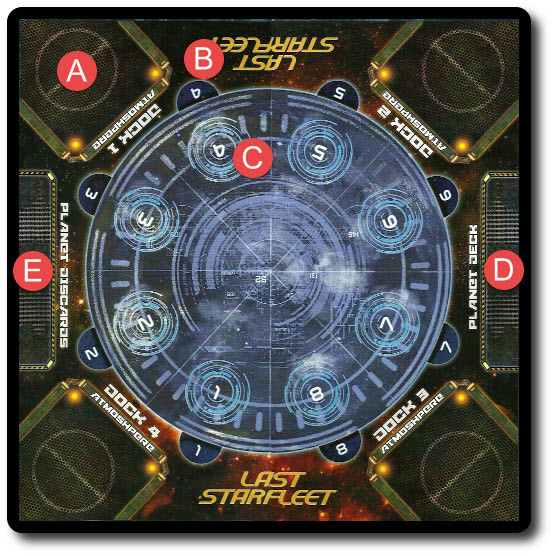
A) Atmosphere Dock Space: Used to dock Planet and Ship cards during the game. There are 4 Atmosphere Dock spaces in total. Only 1 card can be in a Dock space at a time.
B) Orbit: These numbers indicate the orbit position above the planet. They correspond with the planet sections below.
C) Planet Section: These numbers indicate the land position where colonies will be placed.
D Planet Deck: The Planet deck is placed here, face-down, during game set up.
E) Planet Discard Pile: All Planet cards that are drawn and resolved are placed in this discard pile.
Third, shuffle the Planet cards and the Orbit cards together to create the Planet deck. Place this deck next to the Planet board, face-down, in its designated area. This is the Planet draw deck for the duration of the game and includes encounters and events on the planet’s surface and in space. None of which are good for the ship and crew.
Fourth, each player selects a Ship deck and sets aside their “Ship Dock 1”, “Ship Dock 2”, and “Ship Dock 3” cards. These represent the ship, the ship’s captain, and crew quarters. Place these three cards face-up in a row in front of each player. This area is now referred to as the “Ship mat” for the duration of the game. Shuffle the remaining Ship cards and set them face-down next to the player’s Ship mat. These cards are referred to as the Ship draw deck for the duration of the game.
Note: Make certain 1 player selects the ship identified as the planet’s Nemesis. This ship was noted on the Planet Description card. Failure to do so will put the players at disadvantage.
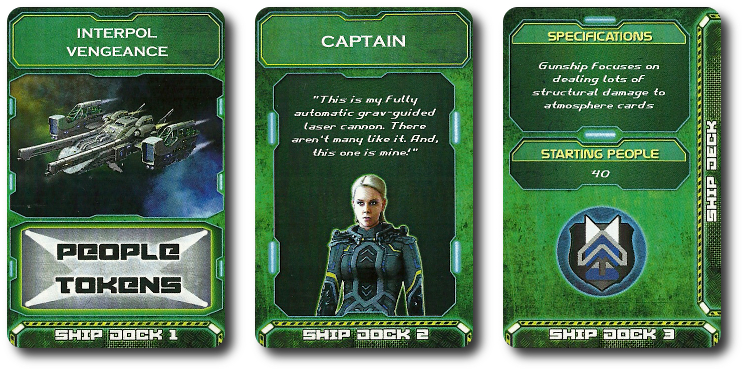
And introducing Charlize Theron as “Captain” of the good ship Interpol Vengeance
Players should not take their Ship selection lightly. Each ship plays slightly differently, giving each player a bit more strength in the areas of landing and supporting. Each ship’s primary mission is described on the Ship mat’s “Specifications” section. The specification will not come out and tell you how to play the ship, but they do provide guidance on how the ship could be used, and even more importantly, how the ship will act when it’s not being crewed. The ships are as follows:
- Interpol Vengeance: A powerful gunship capable of dealing a lot of damage to other structures in space.
- Gadget: A utility ship that is the equivalent to a “Jack of All Trades”.
- HMS Providence: A massive colony ship built to deposit people quickly and defend itself while doing so.
- SS Transformation: A ship equipped to protect colonies if provoked into action.
Fifth, give each player a number of People tokens equal to their “Starting People” number found on their Ship mat. These tokens represents the player’s crew. Some will stay behind to man the ship, some will venture down to the planet’s surface, and most will die, so don’t bother learning their names. The tokens come in values “1”, “5”, and “10”.
Sixth, players now agree on the game’s difficulty level. The difficulty level defines how many total People tokens must be on the planet’s surface in order to win the game. The harder the difficulty, the more people on the planet are necessary. Before selecting a difficulty level, players should determine if they have a good landing ship among them and the general danger level of the planet they are attempting to colonize. In all cases, I suggest the easiest difficulty level for your first game and work your way up to the most difficult game play. Planets have a tendency to look a lot less threatening than they really are. The suggested difficulty levels are as follows:
- Cadet (Easy) – 85 People
- Captain (Medium) – 100 People
- Commander (Hard) – 125 People
That’s it for game set up. Each player now draws 3 Ship cards and collectively decides who will be the first player for the duration of the game.
Good luck, captains. You are going to need it…
Dangers Above, Dangers Below
Last Starfleet is played in rounds (referred to as “cycles”). Each round consists of 3 turns. A round of game play is summarized here. At anytime a card requires “Hit Points”, place a number of unused People tokens on the card equal to the Hit Point value listed.
Note: Everything in the game is driven by the cards played. The cards describe the action and define the game play. Since the cards drawn and played are random, the outcome of every turn, round, and game is different. Players will spend most of their time “reacting” versus “acting”, which thematically makes a lot of sense. The players are attempting to do something dangerous with an outcome that is not clear. Due to the game’s variable nature, the game play is summarized here. Actual game play will depend on the cards you draw and how the player’s respond.
Turn 1: Down on the Planet
The first turn of every round focuses on the planet’s surface. The planet the players are attempting to colonize can support human life, but that doesn’t mean it’s hospitable. Many dangers await the new colonists. Some of the dangers have teeth. Space is not a friendly place, either. The Planet deck contains dangers for those in the ship and those on the ground, leaving no place safe to hide.
The first player now draws 1 Planet card and reads it out loud. All the players then help resolve the Planet card if applicable.

From left to right: “Red Giant” Planet card, Orbit card, and “Leviathan” Planet card
After a Planet card has been resolved, it’s discarded and another Planet card is drawn. The total number of Planet cards drawn during this turn is dependent on the number of players. The more people you drop on the planet, the more bad things happen. In a 2-player game, 2 Planet cards will be drawn. In a 3 or 4-player game, 3 Planet cards will be drawn. In a 5 or 6-player game, 4 Planet cards will be drawn.
Turn 2: Up in the Atmosphere
During the course of the game, some of the game cards will be “docked” to the Atmosphere spaces on the Planet board. A docked card remains face-up in 1 of 4 different Dock spaces on the Planet board. Cards will come and go from the Dock space as they are replaced by newer cards. Starting with Dock space “1” and continuing in sequential order, each docked card is read to determine if any action is necessary or effects should be resolved. Some of the docked cards will affect the game just once, only when certain conditions apply, or will have a constant effect on the game until removed.
Turn 3: In the Captain’s Chair
In turn order sequence, each player now decides if they want to play 1 Ship card from their hand or move 1 Player token to their Ship mat. Not both. The choice will be made based on the game’s current condition and how well off the players are.
Play a Ship Card
Each ship card describes an action. The player reads the action out loud and completes it, but only if the action is possible. Actions include moving people, dropping people off on the planet, and other ship related things. If the Planet cards contain nothing but trouble, the Ship cards are the direct opposite. Each is designed to assist the players, but some of the actions they provide will require the player to put themselves in harm’s way.
Like the Planet cards, some of the Ship cards can be docked. These are connected to the player’s Ship mat and provide continual, conditional, or one time effects.
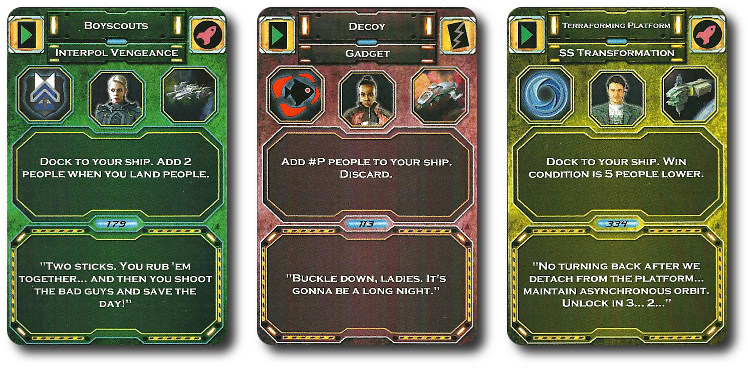
From left to right: Ship cards from the Interpol Vengeance, Gadget, and SS Transformation
Add One People Token
If the player has a People token next to their Ship mat, they can add “1” token to their ship. Thematically speaking, you are prepping a normal crew member to drop down to the planet. Only People tokens on your Ship space on the Ship mat can be sent to the planet. All the Player tokens to the side of the Ship mat are considered ship crew. Players can make change using the different valued People tokens if needed.
After the player completes their turn, they draw 1 Ship card and add it to their hand. There is no hand size limit.
Docking Procedures
“Docking” is a very important action in the game. It allows a player to take a card and place it to 1 of the 4 Docking spaces on the Planet board or to 1 of the 3 Docking paces on the player’s Ship mat. Docked cards remain in play and sometimes provide an ability. They can also be used as a weapon to knock other docked cards out of play. Whenever a card is played to a docking spot that is already occupied by another card, the card that previously occupied the spot is discarded along with any People tokens on it that are standing in as Hit Points.
In the Vacuum of Space
All combat is initiated by the Planet and Ship cards that describes what the attack is, how it affects the player, and where. Players have cards they can play as a “reaction” to the Planet card to defend themselves and others. Damage comes in different types and the keywords are used to identify if another card can or cannot block it. Regardless of type, damage is damage. For every 1 damage inflicted, “1” Player token is lost. Damage will target the planet’s surface and the player’s ship. If too much damage is taken, resulting in losing all the crew or all the colonies, the players will struggle to win the game. Player tokens are a limited resources. Once lost, they are gone forever.
On the Planet’s Surface
The only way players can win is by depositing people to the planet’s surface. This is done on the player’s turn using a Ship card that allows a specific number of People tokens to be placed on the Planet board. On the Planet board are 8 sections. Each section has a number value and is referenced by the cards as “Section” or “S” followed by a number. For example, “S8” indicates Section 8 on the planet’s surface.
Players will be placing People tokens from their ship to any of the sections on the planet. Players should scatter and diversify as much as possible to reduce a catastrophic loss of their colonies. In other words, players should not place their colonies all in the same section of a planet. Like taking damage in space, any damage dealt to a section removes Player tokens.
Ending the Round and Ghost Ships
After all the players have completed their turn, the round comes to an end. A new round now begins starting with the first turn described above.
During the game, a player might send their last crew member to the planet or the last crew members on their ship perish. A ship without a crew is referred to as a “Ghost ship” or simply going “Ghost”. Ghost ships are not floating derelicts above the planet’s surface. Far from it. When there are no people on the ship, the on board AI kicks in and runs the show.
In game terms, the player represents the AI taking over by placing all their Ship cards, shuffling them together, and placing them face-down out of play. The player will no longer be drawing and playing their Ship cards for the time being. Instead, the player will use the ships’ “Ghost Ability” noted on the back of their Ship mat when it’s their turn. That is, until the ship once again has a crew. The player’s team members can send over (give) Player tokens who will then man the ship. When this happens, the player draws Ship cards again, thematically representing a “person” is making the decisions instead of computer.
For example, the AI protocol for Interpol Vengeance, perhaps the last remaining gunship in human history, switches to full tactical and battle mode by automatically attacking 2 targets per round and giving other ships a tactical combat advantage. As such, it’s not always a bad thing when a ship is piloted by its AI instead of a player, but the trade-off should be obvious. A player can adapt to ever-changing game conditions using multiple Ship cards where an AI cannot.
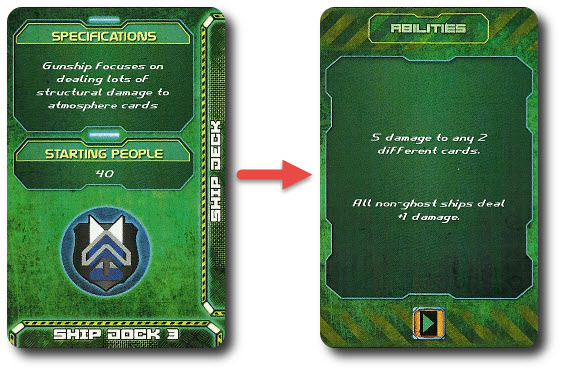
Going Ghost doesn’t mean you are out of the game, it just means you have less to think about…
Ending the Game
The game can end 1 of 3 different ways.
If every player has a ghost ship, humanity has perished. The ghost ships will continue to orbit the planet until their fuel or power runs out. At which point, they will drift forever in space or burn up in the atmosphere as they crash down into the planet. Either way, a sad end to the human race.
If the players ever do a quick check at the table and determine they don’t have enough People tokens to place on the planet to satisfy the victory condition, they have lost. Without enough people to colonize the planet, the human race is doomed to extinction.
However, if the players are ever able to populate the planet with a number equal to or greater than the People token value set by the game’s level of difficulty, then the player’s have won. Enough people have now colonized the planet to establish a permanent foothold. Survival is not certain, but at least there is now a chance. What comes next is up to the players’ collective imaginations.
To learn more about Last Starfleet, visit the game publisher’s website or visit the Kickstarter campaign.
Final Word
The Child Geeks had a rough time with Last Starfleet. They normally do very well with cooperative games, but this was not to be the case here. None of the Child Geeks had difficulty understanding how the game was played, but they continually had difficulty playing as a team. It was common for one player to “take charge” and the rest of the players to give up. This was especially the case when it seemed the game had won before the game was technically over. According to one Child Geek, “This game is too hard!” Yes, it’s a difficult game to beat. Some of the Child Geeks took this personally. One said, “I hate this game! All it does is make it impossible to win!” Impossible? No, but it certainly feels that way at times. When paired with Parent Geeks, the Child Geeks improved and so too did their attitude towards the game. Once the Child Geeks felt like they were on the winning side, they started to have fun. But he damage was done and none of the Child Geeks thought that Last Starfleet was a game they wanted to play. All the Child Geeks voted to reject the game.
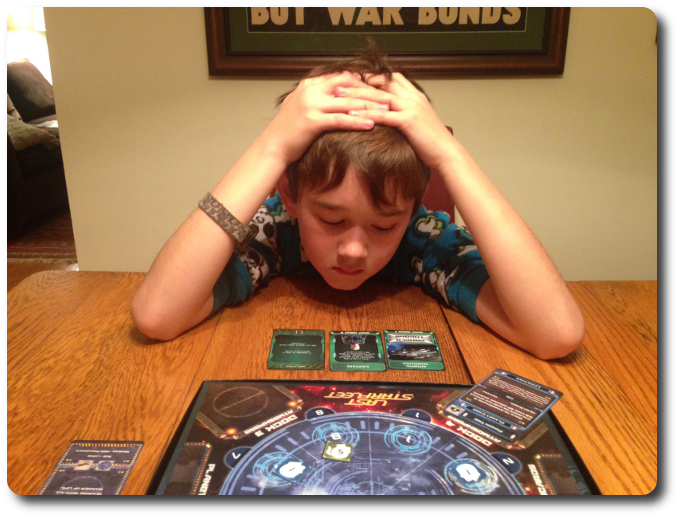
When my oldest little geek’s ship went Ghost, he lost all interest in the game
As I have stated before, the Parent Geeks fall into two different categories. Those who enjoy more casual games and those who enjoy more involved games, but seldom have the time to play them. For those Parent Geeks who enjoy casual games, they found Last Starfleet to be a game full of too much intensity and activity. As one Parent Geek put it, “Good game, but gads, is it a hard game to beat!” The game’s difficulty left the Parent Geeks wondering if they had spent their evening playing a game that wasn’t worth their time when the objective was to just have fun. One Parent Geek said, “I don’t know if I want to play this game again. It was easy to learn, but I have no idea if I played it correctly. We lost, so I’m guessing we didn’t.” Actually, they did, but they didn’t play it well enough to achieve victory. On the other hand, the Parent Geeks who did enjoy more involved and difficult games really had a good time with Last Starfleet. One very excited Parent Geek said, “Neat, neat game! I love the cooperative game play. I love the danger. I love the tension! Great game!” After many games and many tears (with only a few cheers), the Parent Geek vote was mixed, leaving Last Starfleet in limbo.
The Gamer Geeks really dug their heels into this game, talked it out, did their best to win, and lost just as many times as they won. One Gamer Geek said, “This is a really difficult cooperative game. It’s full of strategy, tactics, and lots of teamwork. If you don’t work together, you don’t win.” Another Gamer Geek said, “I think the game is still a bit rough and it needs a lot of spit and polish in some places, but it’s very playable. Playable and enjoyable. Good stuff.” All the Gamer Geeks agreed that Last Starfleet was a game worth putting on their gaming table and their time, despite it making them angry. As one Gamer Geek put it, “I hate this game. I love this game. Let’s play it again.”
Last Starfleet can be an exceedingly difficult cooperative game to beat if the players aren’t working together. However, at no time did I feel like what I should do was in question. You have to play the odds in this game and do what needs to be done to get you just a little bit further down the road. Sometimes this means dropping off as many people as you can to the planet’s surface and other times it means running around fixing things or blowing things up. Every game felt tense and the game play unfolded like a science fiction adventure movie. You will make sacrifices, you will take many for “the team”, and don’t be surprised if your ship goes Ghost more than once per game.
While the diversity of each Ship deck is subtle, it’s there. I like this, as it suggests that every ship is capable of doing the other ships’ job, but not as well. In the same way a pickup truck could pull a trailer much easier than a motorcycle, but a motorcycle could still do it if need be. It also plays well to the game’s theme and narrative. Earth was struck by a disaster with no time to prepare. The ragtag remains of humanity are not well-organized or grouped. All that we are left with is a handful of survivors from different walks of life now thrown together. The only ship with a real advantage over the planet is the noted Nemesis, which is a terribly misleading title. In game terms, the Nemesis ship is the one that is best outfitted for the job, but is in no way capable of winning the game without a serious amount of help. Knowing this, players can use the Nemesis ship as their spear point and formulate strategic and tactical plans around it. This also means that the players will be doing a lot of shielding for the Nemesis ship. However, and this must be pointed out, losing the Nemesis ship does not mean defeat. It just means the players have lost their most formidable weapon. If the Nemesis goes Ghost, then players need to send Player tokens to it so it can once again join the fight.
And a fight it is. This is a game that takes great pleasure in punching you in the face. Every bad thing you can think of will happen. Again, thematically speaking, this makes sense. The players are attempting to land on a planet without much prep or training. They are doing everything they can to survive without any indication that the choices they are making are the right ones. Trial and error is the best teacher in Last Starfleet, but the players don’t have unlimited “do overs”. Depending on the difficulty level, they will have a finite number of mulligans, but even at the easiest game difficulty level the odds of victory are not stellar.
The game itself has some tightening up to do. With the understanding that the game we were provided was a prototype, the rule book was highly ambiguous when it came to specific details regarding game play. There is enough in the rule book to get players started, but a lot of the game you learn as you go. What the rule book is missing is an end-to-end discussion with the reader that gets them from “A” to “Z”. Instead, it provides a summary and a glossary with nothing to help players determine how cards interact. In short, the rule book doesn’t teach you how to pay. It says “hi” and kicks you into the game. Players only get to know the game when they are in the thick of it, fighting to win, and running around like intergalactic chickens with no heads. As such, Last Starfleet is a game you don’t know how to play until after you play it. I know that makes little sense, but that’s the best way to describe it. You’ll be playing blind the first game, but your eyes will be wide open by the time the game is done. Thus the moderate learning curve for all players.
The game is played with the cards. In fact, everything is controlled by the cards. What is done, when, to whom, and where is detailed. If you are the unlucky sap to be in a certain section at a certain time, you get the pummeling. Players don’t know what is coming next, so they must prepare for the worst of everything. The rule book is no help here, but nor is it needed. For example, a Planet card will tell you that a lava field just showed up in a specific planet section. If the players had any Player tokens in that specific section, they are removed. You don’t need a rule book to tell you how to go about doing that. Still, for first time players, you don’t jump into the game feeling like you know what you are doing. We observed that none of our new players had any confidence in themselves whatsoever. The team player suffered as a result.
Last Starfleet is a game that presents the players with a very large and unstable base to build multiple strategies, but no roadmap is provided. This makes the game feel a lot more risky than it is, and any player who is naturally risk averse will have a difficult time playing this game. Very few of our players liked Last Starfleet after their first game, but many of our players started to enjoy it more and more after additional plays. This is a game that becomes clearer the longer you look at it. You’ll spend time thinking about what happened and then going through the different scenarios in your head. This is also a game that is prone to having one player taking control of the last starfleet. Don’t let that happen. Part of the fun of this game is working with people to meet the objective. Captains of different ships are supposed to agree on the mission objective, but not how about to complete the mission. This game teaches as you play it and there is much to learn. Just know that the Planet is a harsh and merciless instructor.
You can win, but you really have to work for it.
If you like cooperative games with a highly thematic feel, lots of strategy, risk, tactics, and punches to the gut, then Last Starfleet is for you. This is not a casual game even though the game play is very straight forward. Nor is this a game you should throw in front of young or inexperienced players without first understanding you are going to burn some emotional bridges. This is a difficult game to grasp and an even more difficult game to master. While the planet and all of its dangers are a serious obstacle to overcome, the biggest challenge is working together as a team. In the end, what will determine if you are victorious is not luck or skill, but cooperation and communication.
This is a paid for review of the game’s final prototype. Although our time and focus was financially compensated, our words are our own. We’d need at least 10 million dollars before we started saying what other people wanted. Such is the statuesque and legendary integrity of Father Geek which cannot be bought except by those who own their own private islands and small countries.



